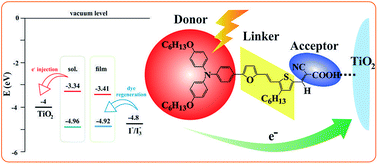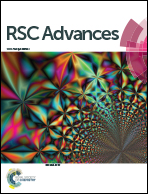A new sensitizer containing dihexyloxy-substituted triphenylamine as donor and a binary conjugated spacer for dye-sensitized solar cells†
Abstract
The synthesis and application to dye-sensitized solar cells (DSSC) of a new dihexyloxy-substituted triphenylamine-based organic dye is reported. The dye design, based on the push–pull concept, consists of dihexyloxy-substituted triphenylamine as an electron donor and a cyanoacrylic acid as an anchoring group and electron acceptor connected through a π-conjugated bridge. The electron spacer containing furan and thiophene moieties was employed in the dye sensitizer for expansion of the π-conjugated fragment to adjust the absorption spectra and HOMO–LUMO levels of the dye. The relationship between the dye chemical structure and the photophysical, electrochemical, and photovoltaic properties determined by spectral, electrochemical, photovoltaic experiments, and density functional theory calculations was thoroughly investigated. The photovoltaic performance of the dye as sensitizer was assessed in DSSC cells realized using electrolytes containing the iodide/triiodide redox couple. The cells obtained with the new dye show a power conversion efficiency of 5.14%, without using any coadsorbant and optimization.


 Please wait while we load your content...
Please wait while we load your content...